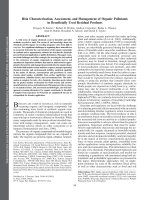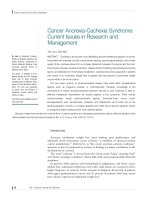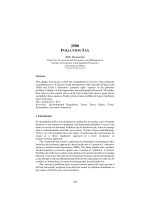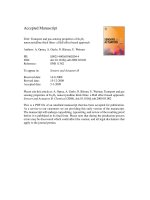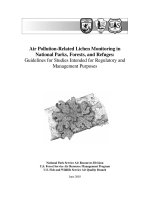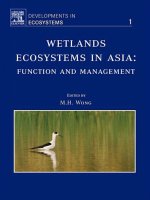Current policy instruments, initiatives and management practices
Bạn đang xem bản rút gọn của tài liệu. Xem và tải ngay bản đầy đủ của tài liệu tại đây (3.57 MB, 34 trang )
Current policy instruments,
initiatives and management
practices
Environmental pollution control
includes
Development of legislative documents for environmental
pollution prevention and mitigation
Pollution inspection
Monitoring
Pollution factors in EIA
Auditing and forecast of pollution, wastes, environmental quality
Development of standards for quality, wastes, technologies
Establishment and implementation of pollution incident
prevention and mitigation, recovery
Education, training, raising awareness of environmental
pollution
Research on pollution
etc.
Environmental pollution control
•
National Strategy for Environment Protection for the period
2001-2010.
Envi. pollution
control
Biodiversity
protection
Envi. quality
improvement
National Strategy for
Pollution Control
Developing and promulgating
legislation on environment protection
•
January 10, 1994: Law on Environment Protection.
•
(now – under revision)
•
1989: People Health Protection Law.
•
1989: Dykes Protection Ordinance.
•
1989: Ordinance of Resources Taxes.
•
1989: Ordinance of Aquatic Resource Protection.
•
1991: Forest Protection and Development Law.
•
1993: Land Use Law.
•
1993: Law of Oil and Petrol.
•
1993: Ordinance of Vegetation Protection and Quarantine.
•
1996: Ordinance of Radiation Safety and Control.
•
1996: Mineral Resources Law.
•
1998: Water Resources Law.
•
1999: Criminal Affair Law.
•
Hundreds of legal documents.
•
Decree No. 36-CT/TW 25 June 1998 of Politburo:
Enhancing environmental protection in period of
industrialization – modernization of the country
Environmental protection
policies and action plans
•
The Government has promulgated series of policies in
order to protect the environment and ensure sustainable
development.
•
Policy of prohibition in production, transport and use of fire-
crackers;
•
Policy of land and forest entrustment for people;
•
Policy of reforestation in bare hills;
•
Policy of stimulation in using cleaner technologies;
•
Policy of biodiversity protection;
•
Policy of closing natural forest,
•
etc.
•
Agenda 21 for Sustainable development and achieving MDGs.
Vietnam Development Goals
(VDGs).
•
Under the framework of a Comprehensive Poverty Reduction
and Growth Strategy (CPRGS)
•
Target 2: ensure that 60% of the rural population has access to
clean and safe water by 2005 and 85% by 2010. This should be
the case for 80% of urban people by 2005;
•
Target 4: ensure that all waste water in towns and cities is
treated by 2010;
•
Target 5: ensure that all solid waste is collected and disposed
safely in all towns and cities by 2010.
Environmental pollution
control
•
EIAs have been implemented for all socio-economic
development projects.
•
Follow-up monitoring?
•
Environmental inspection has been undertaken both at
provincial and national levels.
•
From 1993 to 2000:
•
- Inspected 9,384 enterprises. Among which:
•
- 4,390 (47% inspected) have got administrative
penalties;
•
- 2,175 have been warned;
•
- 2,215 have been fined. Amount of fines: 1,566,810,000
VND (110,000 USD).
•
Environmental inspection
-Weak staff and other resources.
-Frequency is low.
-Fine rates are still low
•
However, the capacity of environmental management institutions in
Vietnam remains weak and disproportionate to their tasks.
•
6 environmental management cadre per 1 mio. population
•
2002: Ministry of Natural Resources and Environment (MONRE)
has been established. DONREs
•
Environmental management authorities are under re-organization
for more effective operation (and co-operation).
Environmental monitoring
•
There are 4 monitoring networks have been established in Vietnam,
including Monitoring Networks of:
–
NEA (EPA),
–
National Hydro-Metereology Center,
–
Department of Geology and Minerals,
–
Department of water resources management, MONRE.
National Network of Environmental
Monitoring
•
Since 1994.
•
Managed by EPA, MONRE
•
By 2002: Network comprised of 20 stations:
- 3 inland stations,
- 3 acid rain stations,
- 2 soil stations,
- 3 radioactive stations,
- 1 labor safety station,
- 450 monitoring points,
- Frequency: once every 2 - 3 months.
•
Basic parameters of air, water (inland and sea water), soil, solid
wastes, noise caused by transportation,
and radioactivity are monitored by these stations.
- 5 marine stations,
- 1 air & water background
quality station,
- 1 laboratory
- 1 central management center
Mostly collected data is served for preparation of Vietnam Annual
State of Environment Report (SOER).
Pressures
Production,
Commerce,
Consumption
Energy, Transport,
Industries, Agriculture,
Forestry, etc.
Environmenta
l status
Air, Water, Soil,
Natural resources,
Ecosystems,
Urban and rural areas
Social
response
Legislations, Strategies,
Policies, New
technologies,
Pollution control,
Consumption change
Conventions, etc.
R
e
s
p
o
n
s
e
s
:
d
e
c
i
s
i
o
n
s
,
a
c
t
i
o
n
s
Pressures
Environment,
natural resources
I
n
f
o
r
m
a
t
i
o
n
I
n
f
o
r
m
a
t
i
o
n
R
e
s
p
o
n
s
e
s
:
d
e
c
i
s
i
o
n
s
,
a
c
t
i
o
n
s
Pollution prevention
•
Further setting up a system of legislative documentation as well as
supporting policies for adequate pollution control.
•
Development of comprehensive and appropriate system of
environmental quality standards.
•
Raising of public awareness.
•
Integration of environmental issues into socio-economical
development plans at different levels.
Pollution prevention
•
Involvement of enterprises in cleaner production campaigns.
•
Development of comprehensive environmental monitoring network
and database management system.
•
Conducting environmental planning at different levels including
macro levels such as national, local and sectoral, using Strategic
Environmental Assessment (SEA), and assurance of commitments
and follow-up activities after EIA report.
•
Setting up of integrated river basin management models for all
major rivers.
Pollution mitigation
•
Up to 2003: Identified 4,295 most polluting locations, including
industrial enterprises, landfills, hospitals, pesticides and chemical
hazards warehouses, etc.
•
22
nd
April 2003: Decision No. 64/2003-QD-TTg by Prime Minister:
Approval of plan for entirely treatment of seriously polluting locations.
•
2003 – 2007: Treatment of 439 most ‘’hot’’ polluting locations, among
which 284 enterprises, 52 landfills, 84 hospitals, 15 pesticides
warehouses, 3 chemical residues warehouses, 1 residue-from-war
bomb warehouse.
•
Up to 2012: Treatment of the rest and new polluting points.
•
Enhancing pollution control and pollution prevention activities.
•
Some of enterprises will be stopped, relocated, or assisted to
renovate existing backward technology and/or to build up waste
treatment facilities.
Pollution mitigation (cont.)
•
Vietnam is trying to build up wastewater treatment plants for
100% national level cities and industrial parks.
Pollution mitigation (cont.)
•
1998. Orientation for urban water supply to the year 2020 issued.
•
•
1999. Orientation for the Development of Urban Sewerage (ODUS)
up to 2020 and the immediate objectives to 2005 issued.
•
2000. National Strategy for Rural Clean Water Supply and
Sanitation for the period up to 2020 issued.
Pollution mitigation. Some facts
•
Significant increase of number of urban sewerage and drainage
projects funded by Government budget or ODA.
•
Arising investment sources for construction and rehabilitation of
sewerage and drainage systems and capacity building for
companies engaged in management of O&M.
•
Japan, France, Denmark, Belgium, Switzerland, etc. and
international financial institutions WB, ADB,
•
ODA funded sewerage and drainage projects in nearly 20 cities
and provincial towns, > 1 USD bio.
•
Hanoi Sewerage and Drainage project, phase I:
USD 200 mio. 1997 – 2003.

